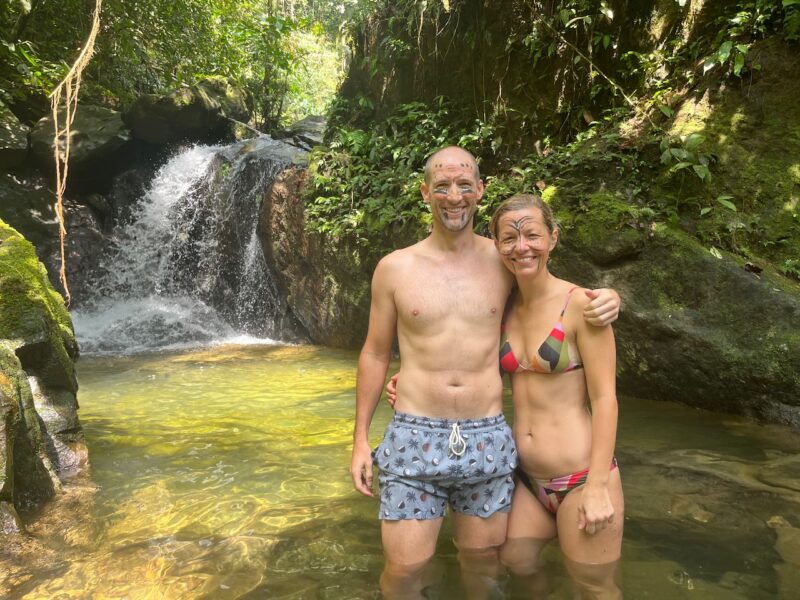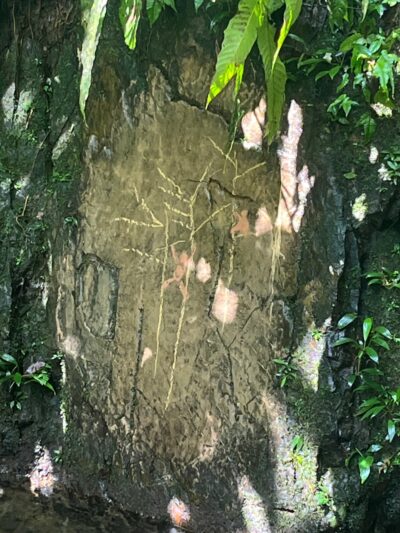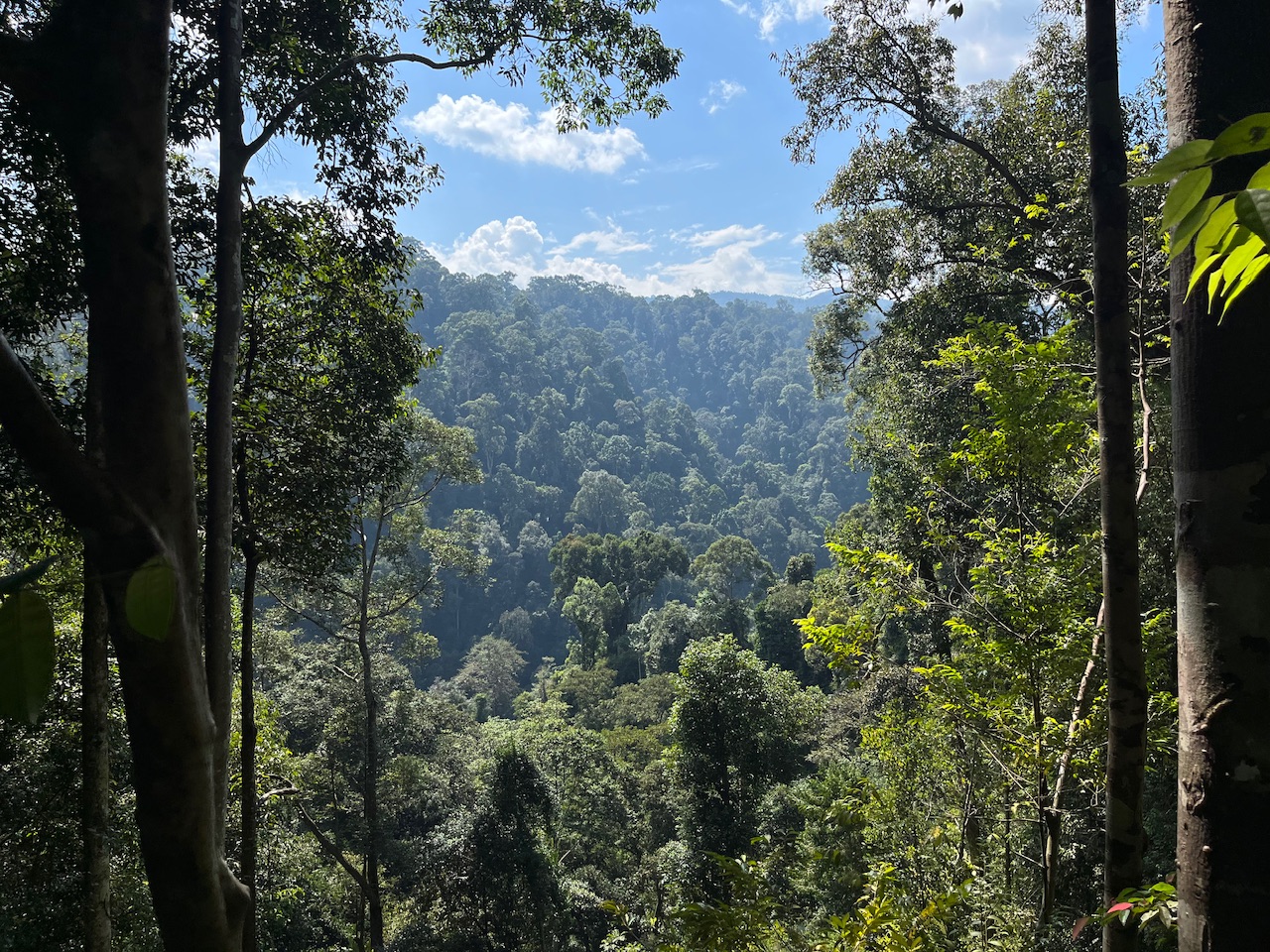One of the parts of the trip Vera and I were both most excited about was the jungle trek in Sumatra and the quest to see Orangutans. We had booked a three day, two night trek (with Sumatra Orangutan Explore, can’t recommend them highly enough) starting from Bukit Lawang in northern Sumatra and heading into Gunung Leuser national park. Apart from the traffic which turned a 130km journey into a 4.5 hour affair, our arrival went super smoothly, the last kilometer of which took us on a “road” about a meter wide which we covered, in the dark, on scooters whose lights would require a lot of generosity to be described as functioning. But our guides were pros and so it was actually a lot of fun.
The next morning we started trekking. Not 20 minutes into the hike and our guide had already spotted a venomous snake (check the photo section), sending all sorts of unpleasant images into our minds. Grabbing snakes instead of branches. Snakes in our tents. Snakes in the toilets (all Vera on this one). Snakes while popping a squat (both of us). Snakes in the plane (kidding, though there was an incident with our airline a couple days before we flew which I didn’t tell Vera about because she’d have panicked). But alas, it was the only snake we saw. But certainly not the only interesting thing we saw!
Apes
Side note: I’ve decided that from now on, there will be an educational component to these otherwise useless ramblings. Things we’ve researched to more fully appreciate or understand what we’re experiencing. Something you probably didn’t know. So here it is, something you probably didn’t know:
Apes and humans are grouped together in the superfamily Hominoidea (the only primates without an external tail), and we’re commonly called Hominoids. There are two families of Hominoids, one includes the gibbons (aka lesser apes, because they’re smaller), and the other includes the five great apes, to which humans, orangutans, gorillas, chimpanzees, and bonobos belong. We humans used to think we were special and part of a family all to ourselves, but recent advances in genetic testing and developments in the fossil record have proved we’re more similar to the other apes than we’d like to admit, thus the shared family. We share about 97% of our DNA with orangutans, 98.7% with bonobos, and 98.8% with chimpanzees. There are 26 Hominoid species in total, and many of them are endangered, including all orangutan species, some of which are critically endangered. Now you know!
So, back to the story. In the Gunung Leuser National Park, where we went trekking, there are two species of gibbons, one of which is endangered, and the Sumatran Orangutan, which is critically endangered. And we saw all of them! We saw the white-handed gibbon (endangered) and the siamang (not). We also saw semi-wild (rehabilitated but now living in the wild) and wild orangutans. Which was awesome. There’s a fucked-up sort of tragic satisfaction in seeing a wild animal which, in the course of our lifetimes, will likely no longer exist in the wild, and maybe not at all. Fingers crossed I’m wrong!
Setting the bitter aside, the sweet is watching these creatures in action. We saw a wild orangutan toddler (five years old) frolicking about, climbing, swinging, descending, without a care in the world.
The gibbons and siamangs were similar. It’s really difficult to film because we deliberately kept our distance and the apes generally stick to the canopies, but you can see below how nimble they are. Only thing that’s missing is David Attenborough!
We saw a ton of other cool things, have a look at the photos, but one of my favorites was this funny looking soft-shelled turtle. Apparently quite tasty to the Thai palate, at least according to our guides. But far too cute for us to eat.

Back into civilization / Medan
On our last day, we hiked to a small waterfall, where our guides painted our faces like the apes using some ground up stones with which we also made some rock art. Our “Still life of orangutans in trees” is not gonna win any awards.


Then we floated half an hour down the river back to base camp, said our goodbyes, and headed to Medan. I had booked a “homestay” which was like a budget hotel, and my god was it awful. The first thing you noticed was the dark-red / brownish handprint smeared on the wall which we couldn’t imagine being anything other than blood or shit, neither of which were particularly confidence-inspiring options. Then we realized there were no windows. Then lots of stains on the mattress. And then lots of black hairs of multiple lengths lying on & underneath the covers, along with a few dead insects. All-in-all, distinctly murder-dungeon vibes. And the funny thing is, the reason we bailed in the end was because we didn’t want to risk bedbugs. We had just come from the jungle and mosquitoes and venomous snakes and poisonous caterpillars and bats and spiders the size of your hand, but this hotel was so gross we thought we’d have it worse there. So we bailed and schlepped our packs a few minutes down the road to a proper business hotel which felt like perverse but delightful luxury. And then we explored Medan, checking out its streetfood scene (nothing compared to Bangkok, and rough for vegetarians) and having a nice walk around. Interesting, but nothing really noteworthy. Seemed like tourists were still so rare that many locals, particularly the 16 and unders, were keen to say hello and give high-fives. Count me in.
Up next: Malaysia

